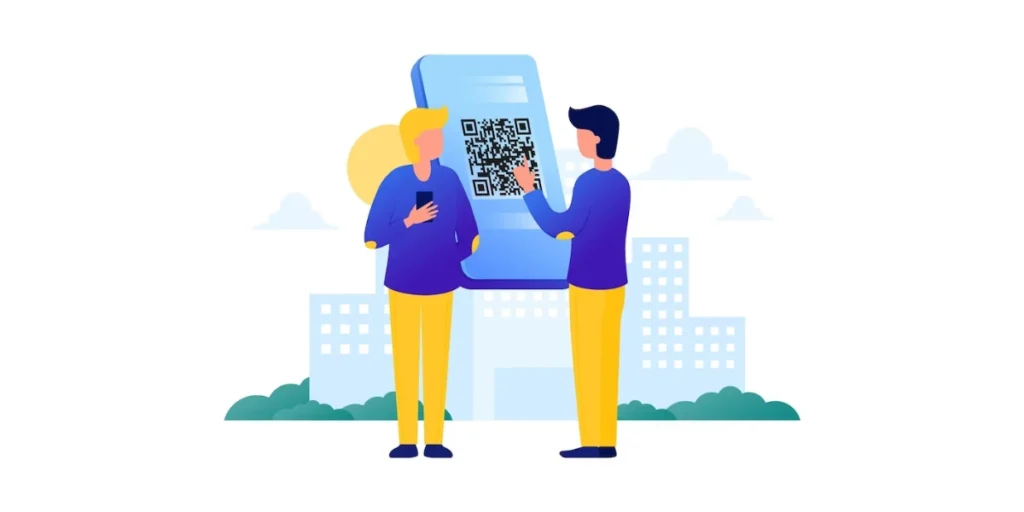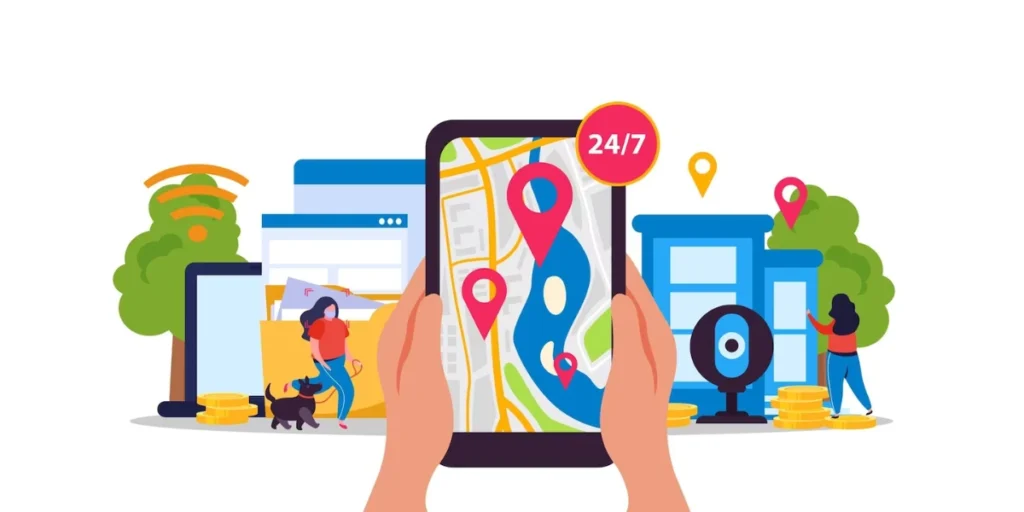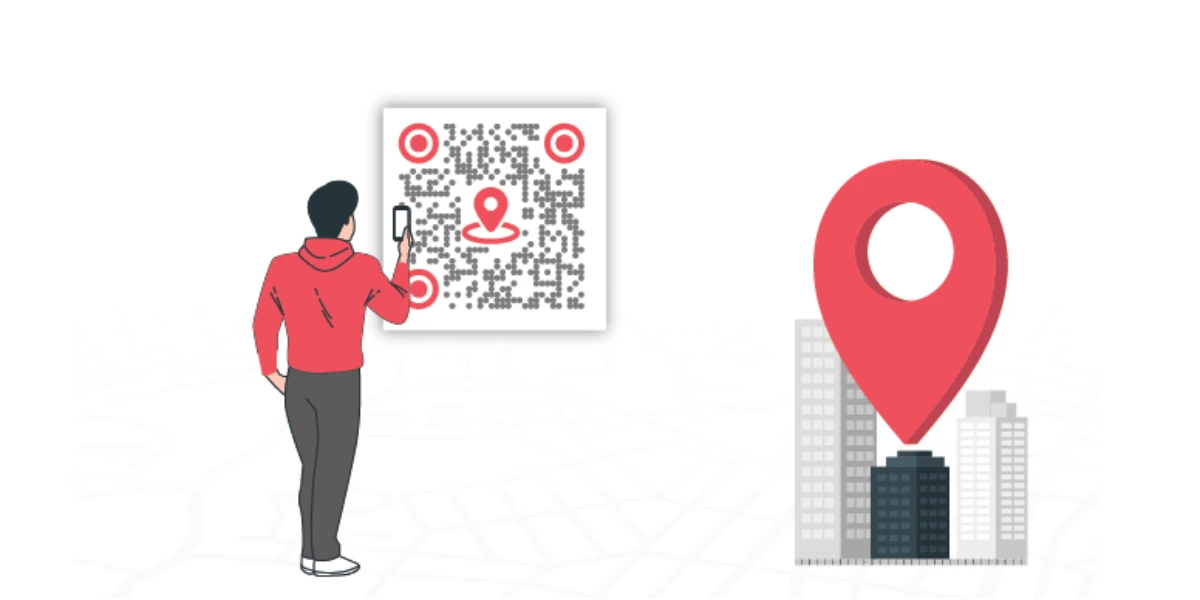Businesses are continually seeking innovative methods to connect with their target audience. QR Code for location-based advertisement is one such prominent tool.
So what does it do?
In simple words, a business can deliver highly targeted content based on a user’s current location.
This blog post delves into the impact of QR Codes in location-based advertising. We will also emphasize their benefits for businesses and consumers.
Discover how QR Codes are revolutionizing customer engagement in the business world. Read the next section to know more!
A. Understanding QR Codes

To harness the potential of QR Codes in location-based advertising, it is crucial to understand their structure and functionality.
QR Codes, known as Quick Response Codes, store information within a pattern of black and white squares.
These can contain various data types, such as URLs, text, and contact information. They can be easily scanned using a smartphone’s camera or a dedicated QR Code scanning app.
B. The power of location-based advertising

Location-based marketing enables organizations to target consumers on an individual level.
They do it by delivering online or offline messages tailored to their specific physical location.
Marketing teams can reach consumers based on factors such as proximity to a store, local events, and other relevant qualifiers.
Location-based marketing is effective throughout various stages of the customer lifecycle.
This strategy targets specific customer segments with personalized offers, enhancing the overall experience.
For instance, location-based marketing can alert potential customers about nearby availability of products. They can then quickly buy the product.
C. Creating location-based QR Codes

Generating QR Codes for location-based advertising is a straightforward process.
There are many online QR Code generators available, but for demo purposes, we’ll be using Scanova.
- First, go to Scanova and, if you’re new, you can sign up for a 14-day free trial
- Once you’re logged in, navigate to the Create QR Code section on the left sidebar
- Choose the Custom Page QR Code from the options available
Alternatively, you can use Quick Search on the top-right (use keyword ‘Custom’) to find this QR Code category
- In the resulting screen, provide the necessary information, which may include:
– Background color of the landing page
– Button: Enter the URL(s) of your website (You can also add additional buttons)
For eg: You can add the website of your store located in New York, Chicago, London, etc. using additional buttons
– Description Box: Add a description of the product or company (You can add more description boxes)
– Banner Image: Upload up to three images related to the product or company (Displayed as a slider on the landing page)
– Social Sharing Button: Specify the social media platforms for users to share the page
- To attach a file to the landing page, select the File component. You can add a document from your computer, Google Drive, OneDrive, or an external link/URL
- To collect data from users, use the Custom Form component. You can add up to 20 questions and export responses as a CSV file
- The Map Location button redirects to a map location. Add this component by selecting Map Location from the available options
- To redirect users to a video, use the Video component. You can attach a video as a file or as a shareable URL
- With Event Tracking, you can track clicks on each button by assigning a unique Tracking ID to each button. Track the clicks in the Analytics via your account dashboard
- Preview the landing page (the page that appears when scanning the QR Code) on the right-hand side
- Once all the information is entered and the preview is checked, click on Continue.
You will be redirected to the Create QR Code screen. Specify additional details and settings for the QR Code
- Give your QR Code a name
- [Optional] Add a tag (or label) to categorize your QR Code for easier searching
- This QR Code type will be Dynamic, allowing editing and tracking. Note that a subscription is required for Dynamic QR Codes beyond the free trial
Advanced settings such as Customize Short URL, Lead Generation, Exact GPS Location, and Password Protection are available
Note: Advanced options are only accessible to advanced users (Standard/Pro plans).
- Click on Create QR Code to generate your QR Code
- View the details of your generated QR Code
- By default, the QR Code design is standard black-and-white. To add a design with colors, patterns, or a logo, click on ‘Edit Design’
- You can either design or directly download the QR Code image. Always test your QR Code before downloading the final image
- When you click on Download, choose the desired image format (PNG, JPG, SVG, EPS, etc.) and specify the required image size (in pixels, inches, cm, or mm)
- You can access and edit your QR Codes anytime in the My QR Codes section on the left sidebar. This is done for Dynamic QR Codes, without changing the actual QR Code
Generate a QR Code For Your Unique Case
START TODAY!
D. Using QR Codes in location-based advertising campaigns

Effectively using QR Codes in location-based advertising campaigns is essential for maximizing their impact.
QR Codes can be used in various locations and mediums within location-based advertising campaigns.
Here are some common places to consider implementing QR Codes:
1. Outdoor advertising
QR Codes can be used in billboards, posters and banners placed in strategic locations.
This could include places such as bus stops, train stations, or busy streets.
Users can scan the code to access more information or special offers related to the advertised product or service.
2. Print media
Magazines, newspapers, brochures, and flyers are print media that can feature QR Codes.
It will lead readers to additional content, exclusive promotions, or interactive experiences.
3. Point-of-sale materials
QR Codes can be placed on product packaging, shelf labels, or display stands in retail stores.
Customers can scan the QR Code to access product details, reviews, or discounts. This will help enhance their in-store shopping experience.
4. Digital platforms
QR Codes can be integrated into websites, social media posts, email marketing campaigns, or digital advertisements.
Users can scan the code to directly access specific landing pages and sign up for newsletters. Additionally, they can participate in contests, or make purchases.
5. Business cards or promotional merchandise
Include QR Codes on business cards, brochures, or promotional items. It will allow recipients to quickly access your contact information, website, or social media profiles.
6. Event marketing
QR Codes can be used on event tickets, invitations, or promotional materials for conferences, trade shows, or exhibitions.
Attendees can scan the code to obtain event details, agendas, speaker information, or exclusive offers.
The choice of locations will depend on your target audience, marketing objectives, and the nature of your products or services.
Ensure that the QR Codes are placed in visible and easily accessible locations. There should be clear instructions on how to scan and benefit from them.
Generate a QR Code For Your Unique Case
START TODAY!
E. Benefits for businesses

QR Codes in location-based advertising offer numerous advantages for businesses.
Implementing QR Codes in location-based advertising campaigns can provide several benefits for businesses. Here are some key advantages:
1. Enhanced customer engagement
QR Codes allow businesses to actively engage with customers.
They do so by providing instant access to relevant information, offers, or promotions related to their physical location.
This increased engagement can lead to improved customer satisfaction and loyalty.
2. Targeted marketing
By leveraging location data, businesses can deliver personalized and targeted marketing messages to customers.
This helps businesses effectively reach their intended audience and increase the likelihood of conversions.
3. Increased foot traffic
Location-based QR Codes can drive foot traffic to physical stores or specific venues. They do so by providing incentives for customers to visit.
For example, a QR Code may offer a discount or exclusive deal for customers who scan it and make a purchase in-store.
4. Data collection and analytics
QR Codes can be used to collect valuable data on customer behavior. It could be factors like the number of scans, locations, and time of interaction.
This data can help businesses gain insights into customer preferences and make informed marketing decisions.
5. Cost-effective marketing tool
QR Codes provide a cost-effective way to deliver targeted advertisements and promotions.
They can be easily created, printed, and distributed across various marketing materials without significant investment.
6. Measurable results
QR Codes allow businesses to track and measure the success of their location-based advertising campaigns.
By monitoring scan rates and conversion rates, businesses can assess the effectiveness of their strategies and make necessary adjustments.
Overall, incorporating QR Codes into location-based advertising offers businesses a powerful tool.
They can engage customers, drive foot traffic, collect data, and optimize their marketing efforts.
F. Benefits for consumers

QR Codes in location-based advertising campaigns offer several benefits for consumers. Here are some advantages:
1. Convenience
QR Codes provide a convenient way for consumers to access information or take action.
By scanning a QR Code, consumers can quickly and easily obtain details.
It could be about products, services, offers, or directions to nearby stores or venues.
2. Instant access to relevant content
Location-based QR Codes can deliver personalized and relevant content to consumers based on their specific location.
This allows consumers to access exclusive promotions, discounts, or special offers that are tailored to their immediate surroundings.
3. Time and effort savings
QR Codes eliminate the need for consumers to manually enter URLs or search for information online.
With a simple scan, consumers can instantly access desired content, saving time and effort in the process.
4. Enhanced shopping experiences
QR Codes can enhance the overall shopping experience for consumers.
For example, they can provide additional product information, customer reviews, or comparisons.
This helps consumers make more informed purchasing decisions while in-store.
5. Interactive and engaging experiences
QR Codes can lead consumers to interactive experiences, such as augmented reality (AR) or virtual reality (VR) content.
Other examples include quizzes, games, or immersive brand experiences. This adds an element of fun and engagement to the advertising interaction.
6. Accessibility for offline promotions
QR Codes bridge the gap between offline and online advertising. It enables consumers to seamlessly transition from physical advertisements to digital experiences.
This allows consumers to access further information or engage with brands beyond what is available in traditional print or outdoor media.
7. Opt-in control
Consumers have the choice to scan QR Codes and engage with the content or offers they find interesting.
It puts them in control of their interactions. It allows them to decide when and how to engage with location-based advertisements.
In short, location-based advertising with QR Codes benefits consumers.
It offers:
- Convenience
- Instant access to relevant content
- Improved shopping experiences
- Interactive engagements, and
- Seamless offline-online connections
Generate a QR Code For Your Unique Case
START TODAY!
G. Best practices for QR Code for location-based advertisement

When using QR Codes for location-based advertising, it’s important to follow some best practices. This will ensure an effective and positive user experience.
Here are some key recommendations:
1. Provide clear instructions
Include clear instructions near the QR Code, specifying what users can expect after scanning it.
Clearly communicate the value or benefit they will receive by engaging with the code.
2. Optimize for mobile devices
QR Codes are typically scanned using smartphones.
Ensure that the landing page or content is mobile-friendly. It should also be optimized for a seamless mobile experience.
Test the QR Code on various devices and screen sizes to ensure compatibility.
3. Offer value-added content
Ensure that the content users are directed to provide valuable and relevant information.
This could include special offers, exclusive discounts, additional product details, or engaging multimedia content.
4. Test the QR code
Before launching your location-based advertising campaign, thoroughly test the QR Code.
Ensure it scans correctly and directs users to the intended destination.
Test it in different lighting conditions and with different scanning apps to ensure maximum compatibility.
5. Consider code placement
Place the QR Code in a prominent and easily accessible location for users.
Avoid placing it where it’s obstructed, too high or too low for comfortable scanning, or in areas with poor lighting.
6. Monitor and analyze performance
Track and analyze the performance of your QR Codes by monitoring scan rates and conversion rates.
This data will provide insights into the effectiveness of your advertising campaign. You can then optimize your marketing strategy accordingly.
7. Keep the code simple and visually appealing
Design the QR Code to be visually appealing while ensuring it maintains its scannability.
Avoid overly complex designs or small sizes that would lead to scanning failures.
8. Regularly update the content
Ensure that you regularly update and refresh the content to provide the most up-to-date information to users.
By following these best practices, you can maximize the effectiveness of QR Codes. This will help you deliver a positive user experience to your audience.
Some FAQs users have
- Where to place QR codes for location-based advertisements?
If using QR Codes in your marketing strategies is on your mind, here are some potential locations where they can prove beneficial:
- At the point of sale
- On your storefront
- Within direct mail campaigns
- On handouts or flyers
- Integrated into packaging
- Printed on shopping bags
- Included on receipts
- Featured on business cards
- How does QR Code location-based advertisement work?
QR Code location-based advertisement works by placing QR Codes in specific locations.
When a user scans the QR Code, they are directed to a landing page where they see buttons based on their location. They can then select the relevant one to get redirected to the target content.
It could be a promotional offer, product information, or event details.
- What are the benefits of using QR Codes for location-based advertisements?
Some benefits of using QR Codes for location-based advertisement include:
– Increased engagement: QR Codes encourage users to interact with your brand by scanning and accessing location-specific content
– Targeted marketing: By placing QR Codes in specific locations, you can tailor your marketing messages to a particular audience or geographical area
– Enhanced user experience: QR Codes provide a seamless way for users to access relevant information or promotions related to a specific location
– Trackable analytics: QR Codes can be tracked, allowing you to gather data on user engagement, scan rates, and conversion rates.
- How can businesses implement QR Code location-based advertisement effectively?
To implement QR Code location-based advertisement effectively, businesses should consider the following:
– Clearly communicate the value proposition to users before they scan the QR Code
– Ensure the landing page or content accessed via the QR Code is optimized for mobile devices
– Regularly update the content behind the QR Codes to keep it relevant
– Analyze the data and insights gathered from QR Code scans to refine your marketing strategies
- Are there any potential challenges or risks associated with QR Code location-based advertisements?
Some challenges or risks associated with QR Code location-based advertisement include:
– User adoption: Not all users may be familiar with scanning QR Codes or may not have a QR Code scanning app installed on their devices
– Technical issues: Poor scanning quality, slow internet connections, or incompatible devices can affect the user experience
– Security concerns: Scanning QR Codes can potentially expose users to malicious links or phishing attempts.
Businesses should ensure the safety and reliability of the content behind the codes
- How can businesses promote QR code scanning for location-based advertisements?
To promote QR Code scanning for location-based advertisement, businesses can:
– Provide clear instructions on how to scan QR Codes and the benefits of doing so
– Offer incentives, such as exclusive discounts or rewards, for scanning QR Codes
– Display QR Codes prominently in physical locations and incorporate them into various marketing materials
– Educate customers about the advantages of accessing location-specific content through QR Codes.
Generate a QR Code For Your Unique Case
START TODAY!
Summing Up
By leveraging the potential of QR Codes, businesses can enhance their marketing strategies.
They can then engage with their target audience in real-time, and drive better outcomes.
As technology advances, QR Codes will play an increasingly crucial role in location-based advertising.
It will provide valuable insights to businesses and tailored experiences for consumers.
If you’re still reading, you’ve already learned everything about QR Code for location-based advertisement. If you have any questions, let us know in the comments.
